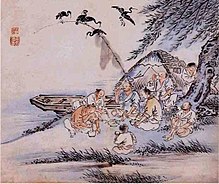Hoe (food)
 | |
| Alternative names | Hwe |
|---|---|
| Type | Raw fish |
| Place of origin | Korea |
| Associated cuisine | East Asian Cuisine |
| Variations | |
| Korean name | |
| Hangul | 회 |
|---|---|
| Revised Romanization | hoe |
| McCune–Reischauer | hoe |
| IPA | [hwɛ] |
 |
| This article is part of a series on |
| Korean cuisine 한국 요리 조선 료리 |
|---|
Hoe (Korean: 회; pronounced [hwɛ]) is a Korean seafood dish that is eaten by trimming raw meat or raw fish. In addition to fish, it is also made with other marine products such as shrimp and squid, raw meat of land animals, and vegetable ingredients, but without any special prefix, it mainly refers to raw fish.
Varieties
[edit]There are uncooked hoe (회) as well as blanched sukhoe (숙회).[1][2]
Raw
[edit]Hoe (회), the raw fish or meat dish, can be divided into saengseon-hoe (생선회), filleted raw fish, and yukhoe (육회), sliced raw meat.[3][4] Saengseon-hoe (생선회) can be either hwareo-hoe (활어회) made from freshly killed fish, or seoneo-hoe (선어회) made using aged fish. Mulhoe (물회) is a cold raw fish soup.[5]
- Baemjangeo-hoe (뱀장어회) – freshwater eel
- Baendaengi-hoe (밴댕이회) – sardinella
- Bangeo-hoe (방어회) – amberjack
- Bogeo-hoe (복어회) – fugu
- Bungeo-hoe (붕어회) – Crucian carp
- Chamchi-hoe (참치회) – tuna
- Daegu-hoe (대구회) – cod
- Dorumuk-hoe (도루묵회) – sandfish
- Gaebul-hoe (개불회) - fat innkeeper worm
- Gajami-hoe (가자미회) – righteye flounder
- Gamulchi-hoe (가물치회) – snakehead
- Gehoe (게회) – crab
- Godeungeo-hoe (고등어회) – Mackerel
- Gul-hoe (굴회) – oyster
- Gwangeo-hoe (광어회) – olive flounder
- Haesam-hoe (해삼회) – sea cucumber
- Hongeo-hoe (홍어회) – skate
- Ingeo-hoe (잉어회) – carp
- Jari-hoe (자리회) – chromis
- Jogae-hoe (조개회) – clam
- Jogi-hoe (조기회) – yellow croaker
- Junchi-hoe (준치회) – ilisha
- Mineo-hoe (민어회) – brown croaker
- Muneo-hoe (문어회) – giant octopus
- Myeongtae-hoe (명태회) – pollock
- Nakji-hoe (낙지회) – long arm octopus
- Nongeo-hoe (농어회) – seabass
- Saengbok-hoe (생복회) – abalone
- San-nakji (산낙지) – long arm octopus
- Songeo-hoe (송어회) – Trout
- Ssogari-hoe (쏘가리회) – mandarin fish
- Sungeo-hoe (숭어회) – mullet
- Munggae-hoe (멍게회) - sea pineapple
- Jeoneo-hoe (전어회) - konosirus
- Ureok-hoe (우럭회) - refers to korean rockfish and Sebastes hubbsi
- Galchi-hoe (갈치회) - largehead hairtail
Blanched
[edit]Sukhoe (숙회) is a blanched fish, seafood, meat, or vegetable dish. Ganghoe (강회) is a dish of rolled and tied ribbons made with blanched vegetables such as water dropworts and scallions.[6]
Khe
[edit]There is a variant of the dish in Sakhalin Korean cuisine[7] called khe. One reported version of the dish served in the Uzbek Korean restaurant Cafe Lily in New York City used catfish that was cured in vinegar, then seasoned.[8]
Preparation
[edit]Hwareo-hoe (활어회) is prepared by filleting freshly killed fish, while seoneo-hoe (선어회) is made with aged fish in a similar way as Japanese sashimi: removing the blood and innards and aging the fish at a certain temperature before filleting.[9][10] Fish or seafood hoe is often served with gochujang-based dipping sauces, such as cho-gochujang (chili paste mixed with vinegar) and ssamjang (chili paste mixed with soybean paste). Hoe is often eaten wrapped in ssam (wrap) vegetables, such as lettuce and perilla leaves. After eating hoe at a restaurant, maeun-tang (spicy fish stew) made with the bones, head, and the remaining meat of the fish, can be served as an add-on dish.
History
[edit]
According to records, hoe appears to have been eaten from Goryeo Dynasty (918–1392) at the latest. During the Joseon period, the state promoted Confucianism, and, as Confucius was known to have enjoyed eating raw meat, hoe consumption greatly increased.[11]
Gallery
[edit]-
Various hoe
-
Bangeo-hoe (raw amberjack)
-
Gaebul-hoe (raw fat innkeeper worm)
-
Godeungeo-hoe (raw chub mackerel)
-
Galchi-hoe (raw largehead hairtail)
-
Gulhoe (raw oysters)
-
Horaegi-hoe (raw loliolus squid)
-
Jaridom-hoe (raw pearl-spot chromis)
-
Muneo-hoe (raw giant octopus)
-
Ojingeo-hoe (raw flying squid)
-
Hoe-muchim (seasoned hoe salad)
-
Hoe-naengmyeon (cold noodles with hoe)
-
Hoe-deopbap (bibimbap with hoe)
See also
[edit]References
[edit]- ^ "hoe" 회. Standard Korean Language Dictionary (in Korean). National Institute of Korean Language. Archived from the original on 19 October 2018. Retrieved 3 June 2017.
- ^ "sukhoe" 숙회. Standard Korean Language Dictionary (in Korean). National Institute of Korean Language. Archived from the original on 6 January 2018. Retrieved 3 June 2017.
- ^ "saengseon-hoe" 생선회. Standard Korean Language Dictionary (in Korean). National Institute of Korean Language. Archived from the original on 3 October 2017. Retrieved 3 June 2017.
- ^ "yukhoe" 육회. Standard Korean Language Dictionary (in Korean). National Institute of Korean Language. Archived from the original on 3 October 2017. Retrieved 3 June 2017.
- ^ "mulhoe" 물회. Standard Korean Language Dictionary (in Korean). National Institute of Korean Language. Archived from the original on 3 October 2017. Retrieved 3 June 2017.
- ^ "ganghoe" 강회. Standard Korean Language Dictionary (in Korean). National Institute of Korean Language. Archived from the original on 27 August 2018. Retrieved 3 June 2017.
- ^ RBTH, Ajay Kamalakaran (2016-07-01). "Russo-Korean cuisine: 7 delicacies from the Russian Far East". Russia Beyond. Retrieved 2023-10-09.
- ^ Mishan, Ligaya (16 February 2017). "At Cafe Lily, the Korean-Uzbek Menu Evokes a Past Exodus". The New York Times. Retrieved 2 January 2019.
- ^ 김, 경운 (26 October 2015). "[김경운 기자의 맛있는 스토리텔링 15] 선어회와 활어회". Seoul Shinmun (in Korean). Retrieved 3 June 2017.
- ^ "고기와 생선, 숙성의 맛". The Chosun Ilbo (in Korean). 27 March 2017. Retrieved 3 June 2017.
- ^ Kim Hak-min (김학민) (2003-07-16). 공자 사모님 힘드셨겠네 (in Korean). The Hankyoreh. Retrieved 2008-08-23.














